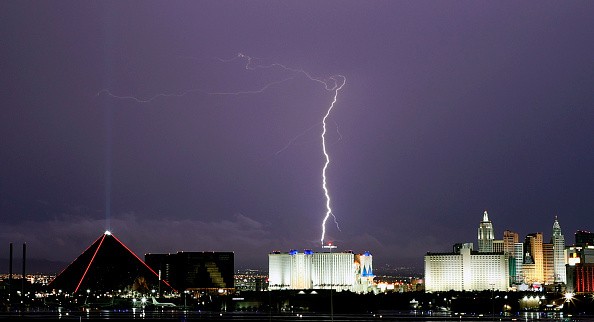The spectacle of lightning forking from the skies to the earth is enough to make anyone nervous. But what if you turn that around?
That's the ideal combination for some horror film that deserves to go viral.
On Tuesday night, video evidence from Wichita, Kansas, captured what homeowner Taylor Vonfeldt described as "the most incredible strike of lightning I've ever seen on tape."
Chris Vagasky of Vaisala, a lightning specialist, told AccuWeather that he agreed with Vonfeldt's reaction.
Upside down lightning?!

It was a pretty remarkable show of what scientists termed as upward lightning, Vagasky said, adding later, "To witness one like this was a little surprise."
He said that these begin at the top of an item, most commonly a man-made skyscraper or communications tower.
While they constitute a small percentage of lightning strikes, they can be spectacular and occur well after the storm, away from heavy rain, allowing common people to catch them with clarity.
The sparks recorded in Vonfeldt's film were amazing.
The video began with his camera in slow motion, fixed on the skies over his neighborhood.
Vagasky stated that this was not the first time he had witnessed such a spectacle and, like Ferrell, felt that adjacent man-made buildings contributed to the remarkable occurrence.
Vagasky saw it for the first time in person in Oklahoma City.
There, all of the local TV stations had their transmitter antennas at a nearby TV tower farm, offering the ideal setting for rising stars to put on a spectacular display.
What is upside-down lightning?
Vertical lightning strikes start on the ground and go upward.
These discharges, which often originate at the top of tall and thin buildings, represent a major threat to wind turbines, as per Phys.org.
An EPFL research investigated the mechanisms underlying these little-understood phenomena.
Is lightning the result of an enraged sky? Not very often. It can even be initiated from the ground in rare cases.
The inverted branches of the lightning that point to the clouds rather than the earth readily identify upward-moving discharges from downward-moving discharges.
Upward strikes are poorly understood phenomena that mostly occur where tall and thin constructions are located on high land.
A researcher from EPFL's Electromagnetic Compatibility Laboratory (EMC) became interested in this issue, investigated it, and eventually wrote his thesis on it.
His findings were published in a recent edition of the Journal of Atmospheric and Solar-Terrestrial Physics.
Ground-to-cloud lightning strikes have been detected since the 1930s, but it is only recently, with the increasing usage of wind turbines, that it has become a significant problem, according to Aleksandr Smorgonskii, a doctorate student at the EMC Lab.
Considering their strength, these discharges pose no danger to communication antennae or buildings.
These iron constructions, outfitted with lightning rods, transmit energy from the bottom to the top, where they escapes unharmed.
Wind turbines, on the other hand, are not the same.
Among the most intriguing data uncovered by the study is the fact that these lofty buildings can record up to 100 more upward hits than downward strikes in a single year.
Furthermore, it appeared that the majority of ground-to-cloud hits occur in the absence of current thunderstorm activity.
Smorgonskii used the Euclid lightning-detection system to identify whether a downward strike had occurred within a 50-kilometer radius less than one second before such a specific upward strike.
Only 15% of the time was this true, that is, more than 80% of ground-to-cloud attacks are begun independently.
Related article : Just What is Lightning? Fatal Phenomena Explored
© 2025 NatureWorldNews.com All rights reserved. Do not reproduce without permission.





